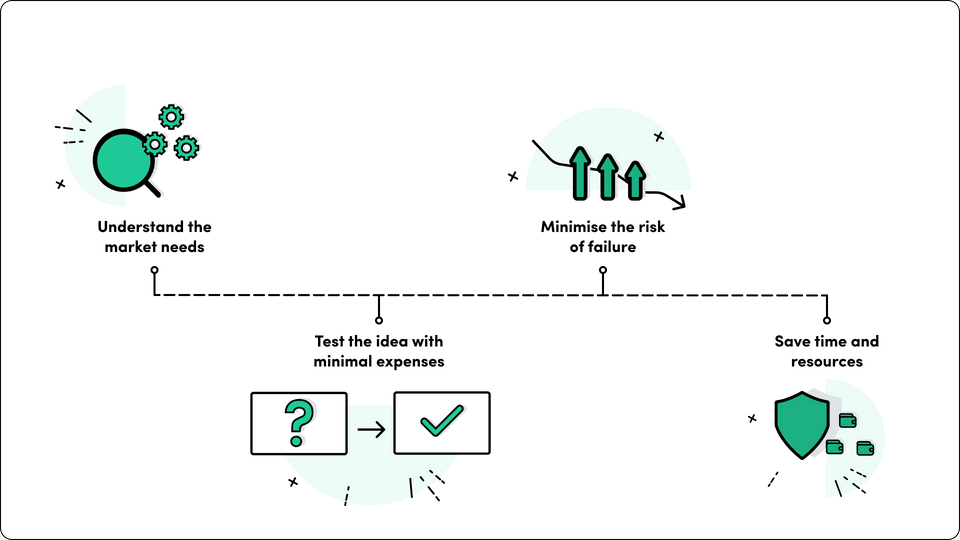You come up with a digital product idea. First, you probably ask your friends and family if it’s a good solution. Then, you google it and do a quick search on the Internet. Have many entrepreneurs, just like you, wanted to launch a similar digital product? How many digital product ideas just like yours is out there? Little by little, you start building your business plan around it. And that’s when the product idea validation process begins.
Validating the idea for your product or anything really usually poses a big challenge. It’s a multi-step process, and it isn’t that cheap. That’s why if you want it to be done effectively, find someone who knows what questions to ask and make something out of collected data. Carry out customer research and see market demand – all of it is part of building successful products. Thus, the next step in your product development journey is heading with the information to your future software vendor. Here’s when our role starts.
Read 3 steps to choosing a software development company and learn more about finding the right team.
How do you tell if a product will sell? What’s the process behind product validation, and how vital is the unique selling point (USP)? Also, what do the lean approach, workshops, and product design sprints have to do with it? In this article, I’ll give you the answers to these (and some more) questions.
Why should you validate your product?
Product validation helps you save time and money. In some situations, it keeps you from putting your resources into something not worth building. But not only that.
It also provides you with information about market needs, as well as your competition and target audience. Thanks to this, you have clarity about the product, so you don’t spend money on anything. You know more about the requirements it should fulfil, which features are necessary and which are redundant. Thus, you can better rate your chances of success – you start selling a product that people are willing to pay for.
Our way – from idea to product launch
As I mentioned before, the beginnings are usually the most complex stages. Figuring it all out and doing research takes a lot of time. The process of testing your digital product idea begins with you. When you gathered the data, you probably start looking for a software development company. And that’s when our new business manager steps in. Here’s what he has to say about his part of the product validation process:
“From my experience, I can sense that the idea is good when it has some foundation. If the client did the necessary research, he could already tell whether or not it will bring value to the market. He has faith in the product. That’s what matters to us. Why? Cause now our role is to turn this idea into reality.”
Mariusz Binkowski, New Business Manager
But naturally, you don’t need to know it all right away. We can help you with that. If you have no idea where to start your research, you should read our ebook. It’ll provide you with the necessary information before beginning your work with the team.
Now, let’s move on to the second part of the process – meeting the team. Whether it’s a video conference or a face-to-face meeting, we always like to gather and talk about your idea. It provides us with a much more understanding of your solution and business.
Project workshop
After the initial meeting, it’s time for research. Usually, we like to do this in the form of a workshop. Sometimes, the research part lasts a few weeks, and sometimes it’s a two-day job. It depends on the type and scope of the project. How much information you, as a client, provide us with also impacts the process.


Have a project in mind?
Let’s meet - book a free consultation and we’ll get back to you within 24 hrs.
The questions
There are many ways to validate the product. Thus it’s tough to describe the actual process. At Gorrion, we seek to gather as much information as possible to build better solutions. In the end, it’s about how to turn your great idea into an actual product.
Before we start any research, we ask you questions, such as:
- Why do you want to create this digital product?
- Why now?
- What inspired you to come up with this solution?
- Why do you think the product would sell?
Competitive analysis
Based on these questions, we perform the research. First of all, we do competitive analysis, which means we check if similar solutions are on the market. There are two possible scenarios. Either there are some competing products, or there aren’t any yet. In that case, we do a market analysis and try to measure the potential of such a product. Is there a need for it in the market?
When we have something on this stage, we meet again with you and give you feedback. Depending on the gathered data, we agree on the existing product or proposing some alterations. Maybe instead of an app, it’d be better to do a game? Or what if we focused on the 20-30 age range instead of targeting the 15-20 age group?
Market research – focus on the target market
In the second scenario, when there are companies with similar solutions, most times, we already have a list of users provided by our client. Hence, we conduct market research and assess how much of the market the companies supply, pay attention to different price points, and check how many active users they have – based on what they like about the existing product, what’s missing and what needs improvement.
On the ground of this, we do, among others, SWOT analysis and the Growth-Share Matrix. As you can see, this customer base gives us a lot of information which are helpful at the later stages. Once you have all of the information about the target market, you can ask yourself one last question – is it worth it?
However, if we don’t have such a list, we look for information on forums, groups, and websites that can provide us with the necessary data during market research. We gather honest feedback from complete strangers. But here’s the trick. The users are more likely to write about problems and missing features rather than what’s good about the product. Because negative feedback is more common, there’s no guarantee that we’ve found our representative group. We can’t be sure that the customer research is reliable since it doesn’t concern all the users but a fraction.
How we differ
Our research team comprises of a product owner, designer and developer. Thanks to such a variety of roles in a group, we can check the digital product idea from different angles. Additionally, sometimes in the early stages, we can already validate specific solutions that we potentially could implement. That’s when we need a developer. In this way, we know right away if it’s doable.
We’re aware that in large firms, people are responsible for one specific job, and that’s why their process looks different. They have a business analyst, a researcher and a tester, whilst at Gorrion, these are product owner’s tasks. In other words, we tend to wear many hats at once.
And sure, sometimes it’s a downside of a situation. But on the other hand, we’re engaged in the process from the research stage to launching the final product and even after that. Because of the early involvement, we understand the project and the market better. Also, as we have the chance to talk to the target audience, we have more insight into the product prototype and better adapt it to their needs. Knowing and trusting the people we work with facilitates the sense of common goal and shared understanding of each other’s tasks.
The “why” instead of “can”
The lean approach is a framework used for measuring product hypotheses at minimal cost and effort in a repeatable way. From the very beginning, we try to implement it in our process.
For that reason, instead of asking whether or not we’re able to build a given digital product, we ask why we should make it. This ‘why’ is related to the fact that we seek to solve the problem of a target group and not build a product for the sole purpose of its creation. What problem product solves? – that’s the vital question. Its users should desire the digital product. And that’s what we’re trying to accomplish.
Minimum viable product (MVP)
Thus, we propose a product design sprint and building an MVP to test product and learn something from it. All of this, to bring the most of the product, to find a unique selling point (USP) so that it meets market needs.
It’s also the reason why we’re looking forward to meeting the target audience. We can see their first impression of the product prototype, gather feedback from the early customers, analyze it, and adapt it to the product to bring the most value. In fact, many options, features, and designs result from continuous tests and opinions from potential customers. That’s what makes successful digital products.
The benefits of MVP
Online experiment with an MVP
It’s a quick-and-efficient way in the product validation process. It may require a little more of your money, but overall it’s really cheap. A landing page campaign is a way to present your brand and your product to your potential client base for their product launch. Many companies started this way. Also, you can boost their interest level by telling them a guaranteed time of when to expect your launch, giving them something to wait for.
The participation and feedback your campaign generates can be used by your team as constructive information both to enhance your idea and to determine the target audience’s level of interest. Their engagement in the experiment is a great way to measure the level of available demand for the product.
Final thoughts on product idea validation
At Gorrion, we don’t blindly build the app or website with what we have, but each time we seek to validate the product from the very first stage. That’s why workshops, building a PoC, MVP and testing are so essential.
From the beginning of our cooperation, we’re focused on your success of the product launch as it’s equally crucial for us as it’s for you. That’s why we carry out internal and external tests – to gather even more feedback, see customers’ preferences and implement it all in a smart way to encourage new customers to buy the digital product.
If you want to talk about your idea or discuss its chances of succeeding on the market, book a meeting with Leo or send us a message. We’d be happy to talk to you. Let’s validate your digital product idea together.
Editor’s note: We’ve originally published this post in December 2020 and updated it for comprehensiveness.


Have a project in mind?
Let’s meet - book a free consultation and we’ll get back to you within 24 hrs.
Ela writes about the fundamentals of great development, project management approaches, ways to develop a proof of concept or an MVP, UX, our company culture, and many other things happening in Gorrion.




